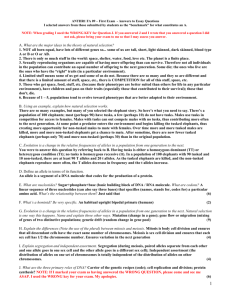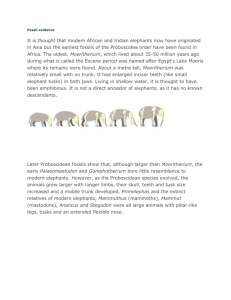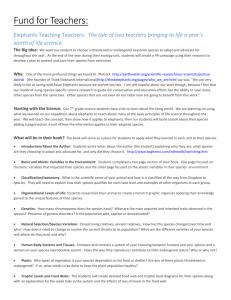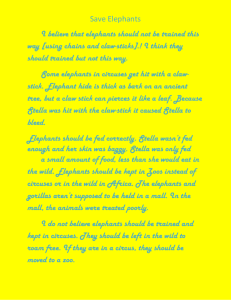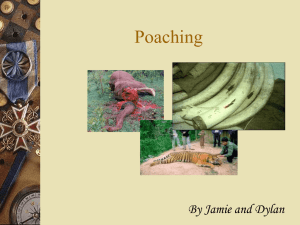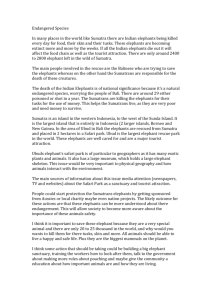ANTHR1 Biological Anthropology
advertisement
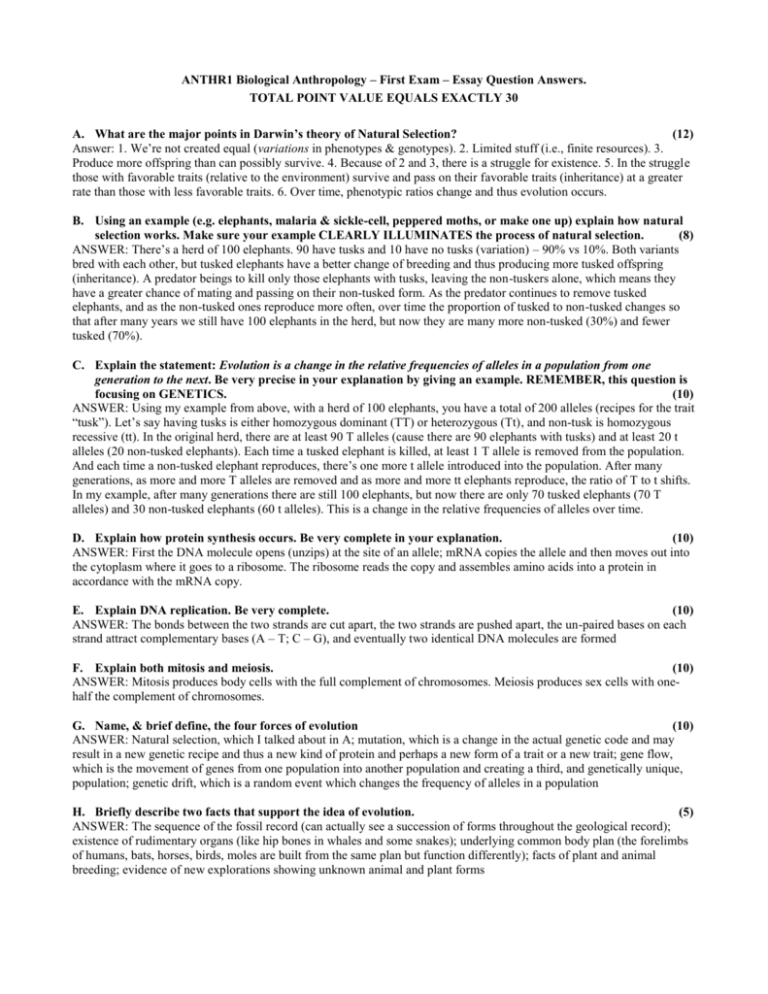
ANTHR1 Biological Anthropology – First Exam – Essay Question Answers. TOTAL POINT VALUE EQUALS EXACTLY 30 A. What are the major points in Darwin’s theory of Natural Selection? (12) Answer: 1. We’re not created equal (variations in phenotypes & genotypes). 2. Limited stuff (i.e., finite resources). 3. Produce more offspring than can possibly survive. 4. Because of 2 and 3, there is a struggle for existence. 5. In the struggle those with favorable traits (relative to the environment) survive and pass on their favorable traits (inheritance) at a greater rate than those with less favorable traits. 6. Over time, phenotypic ratios change and thus evolution occurs. B. Using an example (e.g. elephants, malaria & sickle-cell, peppered moths, or make one up) explain how natural selection works. Make sure your example CLEARLY ILLUMINATES the process of natural selection. (8) ANSWER: There’s a herd of 100 elephants. 90 have tusks and 10 have no tusks (variation) – 90% vs 10%. Both variants bred with each other, but tusked elephants have a better change of breeding and thus producing more tusked offspring (inheritance). A predator beings to kill only those elephants with tusks, leaving the non-tuskers alone, which means they have a greater chance of mating and passing on their non-tusked form. As the predator continues to remove tusked elephants, and as the non-tusked ones reproduce more often, over time the proportion of tusked to non-tusked changes so that after many years we still have 100 elephants in the herd, but now they are many more non-tusked (30%) and fewer tusked (70%). C. Explain the statement: Evolution is a change in the relative frequencies of alleles in a population from one generation to the next. Be very precise in your explanation by giving an example. REMEMBER, this question is focusing on GENETICS. (10) ANSWER: Using my example from above, with a herd of 100 elephants, you have a total of 200 alleles (recipes for the trait “tusk”). Let’s say having tusks is either homozygous dominant (TT) or heterozygous (Tt), and non-tusk is homozygous recessive (tt). In the original herd, there are at least 90 T alleles (cause there are 90 elephants with tusks) and at least 20 t alleles (20 non-tusked elephants). Each time a tusked elephant is killed, at least 1 T allele is removed from the population. And each time a non-tusked elephant reproduces, there’s one more t allele introduced into the population. After many generations, as more and more T alleles are removed and as more and more tt elephants reproduce, the ratio of T to t shifts. In my example, after many generations there are still 100 elephants, but now there are only 70 tusked elephants (70 T alleles) and 30 non-tusked elephants (60 t alleles). This is a change in the relative frequencies of alleles over time. D. Explain how protein synthesis occurs. Be very complete in your explanation. (10) ANSWER: First the DNA molecule opens (unzips) at the site of an allele; mRNA copies the allele and then moves out into the cytoplasm where it goes to a ribosome. The ribosome reads the copy and assembles amino acids into a protein in accordance with the mRNA copy. E. Explain DNA replication. Be very complete. (10) ANSWER: The bonds between the two strands are cut apart, the two strands are pushed apart, the un-paired bases on each strand attract complementary bases (A – T; C – G), and eventually two identical DNA molecules are formed F. Explain both mitosis and meiosis. (10) ANSWER: Mitosis produces body cells with the full complement of chromosomes. Meiosis produces sex cells with onehalf the complement of chromosomes. G. Name, & brief define, the four forces of evolution (10) ANSWER: Natural selection, which I talked about in A; mutation, which is a change in the actual genetic code and may result in a new genetic recipe and thus a new kind of protein and perhaps a new form of a trait or a new trait; gene flow, which is the movement of genes from one population into another population and creating a third, and genetically unique, population; genetic drift, which is a random event which changes the frequency of alleles in a population H. Briefly describe two facts that support the idea of evolution. (5) ANSWER: The sequence of the fossil record (can actually see a succession of forms throughout the geological record); existence of rudimentary organs (like hip bones in whales and some snakes); underlying common body plan (the forelimbs of humans, bats, horses, birds, moles are built from the same plan but function differently); facts of plant and animal breeding; evidence of new explorations showing unknown animal and plant forms


